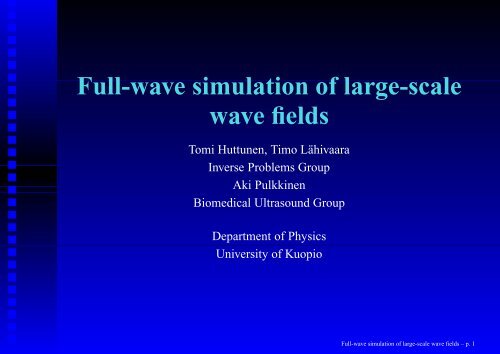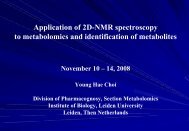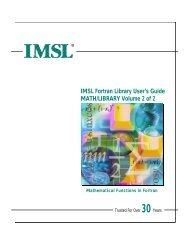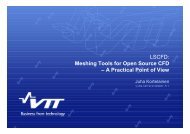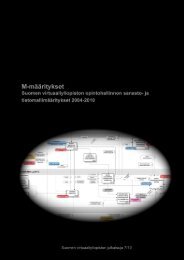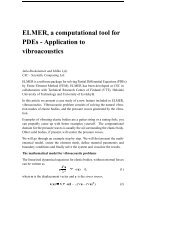Full-wave simulation of large-scale wave fields - CSC
Full-wave simulation of large-scale wave fields - CSC
Full-wave simulation of large-scale wave fields - CSC
You also want an ePaper? Increase the reach of your titles
YUMPU automatically turns print PDFs into web optimized ePapers that Google loves.
<strong>Full</strong>-<strong>wave</strong> <strong>simulation</strong> <strong>of</strong> <strong>large</strong>-<strong>scale</strong><strong>wave</strong> <strong>fields</strong>Tomi Huttunen, Timo LähivaaraInverse Problems GroupAki PulkkinenBiomedical Ultrasound GroupDepartment <strong>of</strong> PhysicsUniversity <strong>of</strong> Kuopio<strong>Full</strong>-<strong>wave</strong> <strong>simulation</strong> <strong>of</strong> <strong>large</strong>-<strong>scale</strong> <strong>wave</strong> <strong>fields</strong> – p. 1
Outline <strong>of</strong> the talk• Background <strong>of</strong> the study• Challenges in the modeling <strong>of</strong> <strong>wave</strong>s• Discontinuous Galerkin methods for <strong>wave</strong>problems (Ph.D. project <strong>of</strong> Timo Lähivaara)• Modeling <strong>of</strong> optoacoustic imaging (MasterThesis <strong>of</strong> Aki Pulkkinen)<strong>Full</strong>-<strong>wave</strong> <strong>simulation</strong> <strong>of</strong> <strong>large</strong>-<strong>scale</strong> <strong>wave</strong> <strong>fields</strong> – p. 2
Background, a short history• The development <strong>of</strong> <strong>simulation</strong> tools started1999.• The application was Focused Ultrasound surgery(an Academy funded project)• A parallel UWVF code for acoustics (2003).• Time domain methods, Timo’s project (2006)• Waveller IPRs currently at spin-<strong>of</strong>f companyKuava Oy (founded 2007)• Waveller used here as a reference solver.<strong>Full</strong>-<strong>wave</strong> <strong>simulation</strong> <strong>of</strong> <strong>large</strong>-<strong>scale</strong> <strong>wave</strong> <strong>fields</strong> – p. 3
Problems with <strong>wave</strong>s• “A rule <strong>of</strong> thumb” for low-order FEM and FDMis ten points per <strong>wave</strong>length λ• Due to the numerical pollution, even densermeshes are needed at high frequencies• Boundary element methods (BEM) becomecomplex for problems in inhomogeneous media• Ray-approximations are commonly used ⇒reduced accuracy<strong>Full</strong>-<strong>wave</strong> <strong>simulation</strong> <strong>of</strong> <strong>large</strong>-<strong>scale</strong> <strong>wave</strong> <strong>fields</strong> – p. 4
Consequently...• Clearly, we can consider that this problem[scattering <strong>of</strong> radar <strong>wave</strong>s by an aircraft]remains unsolved and a completely new method<strong>of</strong> approximation is needed to deal with the veryshort-<strong>wave</strong> solutionO.C. Zienkiewicz: “Achievements and someunsolved problems <strong>of</strong> the finite element method”.International Journal for Numerical Methodsin Engineering, 47, 9-28 (2000)• Special techniques are needed for themodeling <strong>of</strong> <strong>wave</strong>s<strong>Full</strong>-<strong>wave</strong> <strong>simulation</strong> <strong>of</strong> <strong>large</strong>-<strong>scale</strong> <strong>wave</strong> <strong>fields</strong> – p. 5
Discontinuous Galerkin methods (DGM)• The DGM use standard finite elements for spatial discretization• The basis is discontinuous but the continuity <strong>of</strong> the solution is enforcedover each element interface using physical transmission conditions(=numerical flux)• DGM results in a favorable matrix structure (block diagonal mass matrixetc.) and are easy to parallelize.• In the DGM weak formulation, one can also assume that the test andbasis functions are solutions <strong>of</strong> the local <strong>wave</strong> equation (e.g. plane <strong>wave</strong>s)⇒ The ultra weak variational formulation (codes using UWVF: Wavellerand Comsol)<strong>Full</strong>-<strong>wave</strong> <strong>simulation</strong> <strong>of</strong> <strong>large</strong>-<strong>scale</strong> <strong>wave</strong> <strong>fields</strong> – p. 6
DGMs <strong>of</strong> this project• Parallel, time-domain DGM for acoustics andelastic <strong>wave</strong>s (Timo’s Ph.D. project)• Focus on the choice <strong>of</strong> the optimal polynomialbasis.• Waveller (frequency domain solver) used for thecomparison.• Evaluation <strong>of</strong> the parallel UWVF for <strong>large</strong>electromagnetic <strong>wave</strong> problems (modelproblems, for example, from Nokia).<strong>Full</strong>-<strong>wave</strong> <strong>simulation</strong> <strong>of</strong> <strong>large</strong>-<strong>scale</strong> <strong>wave</strong> <strong>fields</strong> – p. 7
DGM implementation• Time-domain DG codes are coded using C++ andMPI for parallelization.• Mesh partitioning using METIS so that load isevenly distributed between processors.• Electromagnetic UWVF is a Fortran90+MPIcode.• Commercial tools for meshing (Gambit, Comsol,...)<strong>Full</strong>-<strong>wave</strong> <strong>simulation</strong> <strong>of</strong> <strong>large</strong>-<strong>scale</strong> <strong>wave</strong> <strong>fields</strong> – p. 8
Acoustic model problemSound from a loudspeaker.<strong>Full</strong>-<strong>wave</strong> <strong>simulation</strong> <strong>of</strong> <strong>large</strong>-<strong>scale</strong> <strong>wave</strong> <strong>fields</strong> – p. 9
Near-fieldSimulated near field at 1000 Hz.<strong>Full</strong>-<strong>wave</strong> <strong>simulation</strong> <strong>of</strong> <strong>large</strong>-<strong>scale</strong> <strong>wave</strong> <strong>fields</strong> – p. 10
Far-field120UWVFDGmeasurementxz plane90160120yz plane901601500.5301500.530180 0180 0210330210330240270300240270300Comparison with measurements.<strong>Full</strong>-<strong>wave</strong> <strong>simulation</strong> <strong>of</strong> <strong>large</strong>-<strong>scale</strong> <strong>wave</strong> <strong>fields</strong> – p. 11
Axial response10.510.8UWVFDGmeasurementAmplitude0−0.5Amplitude0.60.40.2−10 2 4t (ms)601000 1500 2000 2500 3000f (Hz)Comparison with measurements.<strong>Full</strong>-<strong>wave</strong> <strong>simulation</strong> <strong>of</strong> <strong>large</strong>-<strong>scale</strong> <strong>wave</strong> <strong>fields</strong> – p. 12
Elastic <strong>wave</strong>sScattering <strong>of</strong> a plane <strong>wave</strong> from a bar.<strong>Full</strong>-<strong>wave</strong> <strong>simulation</strong> <strong>of</strong> <strong>large</strong>-<strong>scale</strong> <strong>wave</strong> <strong>fields</strong> – p. 13
Electromagnetic scatteringz (m)−2 024100y (m)−10−100x (m)10Model geometry<strong>Full</strong>-<strong>wave</strong> <strong>simulation</strong> <strong>of</strong> <strong>large</strong>-<strong>scale</strong> <strong>wave</strong> <strong>fields</strong> – p. 14
Electromagnetic scatteringScattering <strong>of</strong> EM <strong>wave</strong>s from a full-size aircraft at 0.3GHz.<strong>Full</strong>-<strong>wave</strong> <strong>simulation</strong> <strong>of</strong> <strong>large</strong>-<strong>scale</strong> <strong>wave</strong> <strong>fields</strong> – p. 15
DGM, conclusions• Time-stepping is a challenge for time-domainproblems (high order polynomial basis requiressmall time steps)• Local time stepping might help but may bedifficult to parallelize.• The UWVF method <strong>scale</strong>s well and is suitable for<strong>large</strong> problems.• The challenges for the UWVF are extremelysmall geometric details <strong>of</strong> the model (or lowfrequencies) and singular <strong>fields</strong>.<strong>Full</strong>-<strong>wave</strong> <strong>simulation</strong> <strong>of</strong> <strong>large</strong>-<strong>scale</strong> <strong>wave</strong> <strong>fields</strong> – p. 16
Optoacoustic imaging (OAI)• A short laser pulse (10 ns-100µs) is targeted to atissue• The absorption <strong>of</strong> the light leads to pressure pulsewhich propagates as ultrasound• Measurement <strong>of</strong> optoacoustically generatedsound provides information <strong>of</strong> the optical andacoustical properties <strong>of</strong> the medium.• The aim was study the feasibility <strong>of</strong> the methodfor transcranial imaging <strong>of</strong> veins.<strong>Full</strong>-<strong>wave</strong> <strong>simulation</strong> <strong>of</strong> <strong>large</strong>-<strong>scale</strong> <strong>wave</strong> <strong>fields</strong> – p. 17
Why OAI? Pros and Cons• The aim is to combine best features <strong>of</strong> optical andultrasonic imaging.• Large diffence is optical properties <strong>of</strong> tissues ⇒strong contrast• Good spatial resolution <strong>of</strong> ultrasound.• However, the method suffers from small imagingdepth and weak acoustic signals.<strong>Full</strong>-<strong>wave</strong> <strong>simulation</strong> <strong>of</strong> <strong>large</strong>-<strong>scale</strong> <strong>wave</strong> <strong>fields</strong> – p. 18
Model for Optoacoustic imaging• A Monte Carlo model for the propagation <strong>of</strong>light.• Linear inhomogeneous <strong>wave</strong> equation forultrasound (solved using FDTD).• The <strong>simulation</strong> medium consists <strong>of</strong> a head andbrain <strong>of</strong> mouse(B. Dogdas, D. Stout, A. Chatziioannou, and R.M. Leahy, "Digimouse: A 3D Whole BodyMouse Atlas from CT and Cryosection Data."Phys Med Biol. 2007 Feb 7; 52 (3): 577-87).• The imaging target is blood oxygen saturation.<strong>Full</strong>-<strong>wave</strong> <strong>simulation</strong> <strong>of</strong> <strong>large</strong>-<strong>scale</strong> <strong>wave</strong> <strong>fields</strong> – p. 19
Geometry <strong>of</strong> the modelUS transducer on the left, mouse head on the right.<strong>Full</strong>-<strong>wave</strong> <strong>simulation</strong> <strong>of</strong> <strong>large</strong>-<strong>scale</strong> <strong>wave</strong> <strong>fields</strong> – p. 20
Optical absorptionLogarithmic optical absorption in the mouse head.<strong>Full</strong>-<strong>wave</strong> <strong>simulation</strong> <strong>of</strong> <strong>large</strong>-<strong>scale</strong> <strong>wave</strong> <strong>fields</strong> – p. 21
Acoustic pressureMaximum pressure amplitude in the mouse head.<strong>Full</strong>-<strong>wave</strong> <strong>simulation</strong> <strong>of</strong> <strong>large</strong>-<strong>scale</strong> <strong>wave</strong> <strong>fields</strong> – p. 22
Measured signal600Acoustical pressure as measured by the focusing transducerWithout veinSO 2= 100%SO 2= 0%500400300p (Pa)2001000−100−20015 15.5 16 16.5 17 17.5 18 18.5 19 19.5 20t (µ s)Measured signal at the transducer.<strong>Full</strong>-<strong>wave</strong> <strong>simulation</strong> <strong>of</strong> <strong>large</strong>-<strong>scale</strong> <strong>wave</strong> <strong>fields</strong> – p. 23
OAI, conclusion• The work provided valuable information foroptimization <strong>of</strong> the imaging parameters.• The method still suffers from the weak acousticsignal due to strong absorption in the skull.• Aki’s work continues at Sunnybrook SciencesCentre (University <strong>of</strong> Toronto, Canada).<strong>Full</strong>-<strong>wave</strong> <strong>simulation</strong> <strong>of</strong> <strong>large</strong>-<strong>scale</strong> <strong>wave</strong> <strong>fields</strong> – p. 24
Summary <strong>of</strong> results• The grant gave a unique opportunity for twostudents to perform <strong>simulation</strong>s on the bestimaginable computer (fast generation <strong>of</strong> data).• Two journal papers Timo’s Ph.D. thesis (onesubmitted to IJNME and another in preparation)+ several conference talks• Aki’s MS. thesis + continuation results<strong>Full</strong>-<strong>wave</strong> <strong>simulation</strong> <strong>of</strong> <strong>large</strong>-<strong>scale</strong> <strong>wave</strong> <strong>fields</strong> – p. 25


